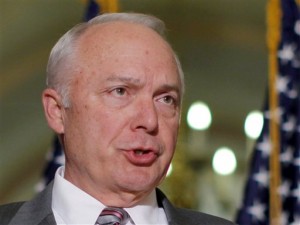Labeled by the Republican chairman of the Education Committee as the starting point in negotiations with President Obama and the Senate, the House of Representatives approved a bill Thursday that links the federal student loan rate to variable financial markets.
Asserting that the bill was proposed in response to a mandate from constituents to “do something,” Republicans largely backed the measure.

“The American people sent us here to tackle tough issues, not kick the can down the road,” House Education and the Workforce Committee Chairman John Kline said after the vote. “The time to act is now. Students, families and taxpayers cannot afford further delay.”
A number of Democrat opponents of the bill were quick to criticize the decision, dubbing it the “Making College More Expensive Act.”
In his proposed budget, Obama also included flexible rate student loan rates that were tied to 10-year Treasury bills. The president did not limit interest rates but did include a smaller added interest rate. The plan also proposed an expanded income-based repayment option and loan forgiveness.
Currently, the federal subsidized student loan rate is set to double from 3.4 percent to 6.8 percent on July 1, 2013, further burdening the most statistically indebted generation of college students in history.
Due to recession pressures and the rising costs associated with higher education, student loans have played an important role in financing college education for many U.S. families. At issue is the fact that students are seeing their loan rates rise while other consumer loan product rates are at all-time lows.
Students expressed frustration Thursday with the White House and Congress for not doing something that will make a difference for students who already feel disadvantaged by the prospect of entering a recession-induced, soft job market after graduation.
“It’s ridiculous that students are being charged 6.8 percent interest when you can get a mortgage on a house for 3.5 percent,” Zach Nostdal, a graduate student at the University of Washington, told the Associated Press.
The Federal Reserve Bank released a report in March stating that student loan debt is the only debt that has grown since the peak of consumer debt in 2008 and is second only to mortgage debt in largest balance. The current figure of $966 billion represents a number that tripled between 2004 and 2012.
Further highlighting the looming crisis, Equifax recently reported that the share of 25-year-olds with student debt increased from 26 percent to approximately 43 percent in that same time period — a rise of 17 percent in the number of people affected in just eight years.
Lawmakers say a two-year extension of the 3.4 percent rate for subsidized Stafford loans would cost American taxpayers about $9 billion, something they have not been able to agree to do.
The Senate planned to take up its own measure next week. However, agreement between the House and Senate versions would have to be reached with unprecedented speed to head off the July 1 rate hike, and local students are skeptical.
Jacquelyne Masotti, a BYU junior from Sunset, Utah, is calculating how she will finance school and live with the consequences of graduating with that much increase in interest debt.
“I did not see the loan rate increase coming, I was so busy with school and work during the fall and winter semesters,” the sociology major said. “I don’t think I can go to school without a student loan … hopefully there’s a workable solution.”
During “Generation I.O.U.,” a live-hosted forum by Yahoo’s Daily Ticker held Thursday before the House vote, not everyone was sympathetic to the plight of those seeking large college loans. Aaron, a 32-year-old forum poster whose parents didn’t set money aside for his college education, earned an ROTC scholarship that covered tuition and housing. His comment was representative of the only-take-what-you-can-pay-back side of the debate.
“I maintained a 3.0 or above GPA while averaging 18 credit hours per semester for 4 years. I took out a total of just under $8,000 in student loans to cover my food. I then paid back my ROTC scholarship by serving as an officer in the Army for four years, including a combat tour in Iraq, and paid my loans in full,” he said. “Now, I’m basically being told that having paid my debt myself, I will be expected to pay for everybody else as well.”




